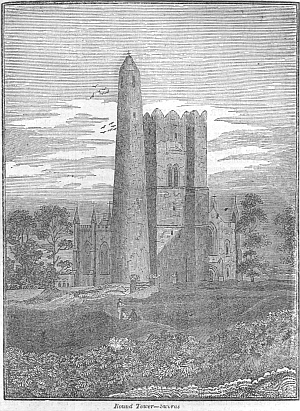The Round Tower of Swords
From The Dublin Penny Journal, Volume 1, Number 23, December 1, 1832.
 The ancient town of Swords, situated in the barony of Coolock, about seven miles from the metropolis, though now reduced to an insignificant village, is remarkable for its picturesque features, its ruins, and its historical recollections. Its situation is pleasing and romantic, being placed on the steep banks of a small and rapid river, and though its general appearance indicates but little of prosperity or happiness, its very ruins and decay, give it, at least to the antiquary and the painter, a no common interest.
The ancient town of Swords, situated in the barony of Coolock, about seven miles from the metropolis, though now reduced to an insignificant village, is remarkable for its picturesque features, its ruins, and its historical recollections. Its situation is pleasing and romantic, being placed on the steep banks of a small and rapid river, and though its general appearance indicates but little of prosperity or happiness, its very ruins and decay, give it, at least to the antiquary and the painter, a no common interest.
Like most of our ancient towns Swords appears to be of ecclesiastical origin. A sumptuous monastery was founded here in the year 512, by the great St. Columb, who appointed St. Finian Lobair, or the leper, as its abbot, and to whom he gave a missal, or copy of the gospels, written by himself. St. Finian died before the close of the sixth century. In course of time this monastery became possessed of considerable wealth, and the town rose into much importance. It contained within its precincts, in addition to St. Columb's church, four other chapels, and nine exterior chapels subservient to the mother church. Hence on the institution of the collegiate church of St. Patrick, it ranked as the first of the thirteen canonries attached to that cathedral by archbishop Comin, and was subsequently known by the appellation of "the golden prebend." There was also a nunnery here, the origin of which is unknown.
To this monastery the bodies of the monarch Brian Boru, and his son Morogh, were conveyed in solemn procession by the monks, after the memorable battle of Clontarf, and after remaining a night, were carried to the abbey of Duleek, and committed to the care of the monks of St. Cianan, by whom they were conveyed to Armagh.
Swords was burnt and plundered frequently, as well by the native princes, as by the Danes, who set the unholy example. By the latter it was reduced to ashes in the years 1012, and 1016, and by the former in the years 1035 and 1135. On this last occasion the aggressor, Conor O'Melaghlin, king of Meath, was slain by the men of Lusk. Its final calamity of this kind occurred in the year 1166.
Here it was that the first Irish army of the Pale assembled on the 9th of November, 1641, preparatory to that frightful civil war which caused such calamities to the country; and here they were defeated and put to the rout by the forces under Sir Charles Coote, on the 10th of January following, when he beat them from their fortifications and killed two hundred of them, without any material loss, except that of Sir Lorenzo Carey, second son of Lord Falkland, who fell in the engagement.
Of the numerous ecclesiastical edifices for which Swords was anciently distinguished, the only remains now existing are those represented in the prefixed engraving--for the castle, though said to have been the residence of the archbishop of Dublin can hardly be included under this denomination. These consist of a fine and lofty round tower, coeval with the foundation of the original monastery, and the abbey belfry, a square building of the fourteenth or fifteenth century. The former is seventy-three feet high, fifty-two feet in circumference, and the walls four feet thick. It contained five stories, or floors. Its present entrance which is level with the ground, is of modern construction, as well as the roof and upper story: what appears to have been the original doorway is twenty feet from the ground, and but four feet high. Respecting the uses of those singular ancient buildings, we deem it improper to express any opinion, till the Royal Irish Academy shall have announced its decision on the prize essays on this subject, now under its consideration.
These two towers with the adjacent church, form a picturesque and uncommon architectural group; but the church which is of modern erection, having been completed in the year 1818, though imposing in its general appearance, is but a spurious and jejune imitation of the pointed or gothic style of architecture, and such as might have been expected from minds so wanting in good taste and feeling as those which permitted the removal of the beautiful ruins of the ancient abbey to erect it on their site. Similar acts of wanton destruction are now unfortunately of daily occurrence, and are anything but honorable to their perpretrators, who, though they may regard such remains as vestiges of ancient superstition, should still remember, as Byron says, that
----"Even the faintest relics of a shrine
Of any worship, wake some thoughts divine."
We are told that the inhabitants of Swords feel proud of this pretending, but tasteless structure, and we believe it possible; but if the principles of a refined and educated architectural taste should ever again be generally disseminated in Ireland, they will indulge in a very different feeling. In this country we have yet to learn that elegance of form and correctness of design in ecclesiastical buildings are, in the hands of a judicious and educated architect, quite attainable, even with the limited means usually appropriated to the purpose.
We shall give a view and account of the castle, or episcopal palace of Swords, in a future number.
G.
